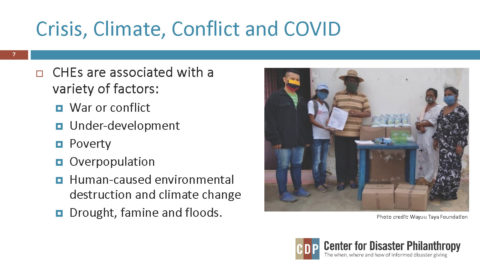What is Giving Compass?
We connect donors to learning resources and ways to support community-led solutions. Learn more about us.
Search our Guide to Good
Start searching for your way to change the world.
Today's most significant humanitarian needs exist in complex humanitarian emergencies (CHEs), yet CHEs are difficult for funders to understand, and very little U.S. philanthropic funding goes to them.
CHEs involve a serious emergency layered on top of ongoing instability. Compounding crises in CHEs today include the layers of crisis, conflict, climate and a global pandemic. How can funders best support affected communities when there are so many different humanitarian emergencies?
To help answer this question, the Center for Disaster Philanthropy (CDP) recently hosted a webinar, Complex Humanitarian Emergencies: Where crisis, conflict, climate and COVID-19 meet. CDP's president and CEO Patty McIlreavy moderated the discussion, and panelists included: Alex Gray, director of international funds at CDP; Lars Peter Nissen, director of ACAPS; and Dominic MacSorley, CEO of Concern Worldwide.

Here are some key takeaways for donors from the webinar:
Funder's response should involve planning and flexibility. CHEs are complex by definition but how you respond to them is similar to any disaster. Researching partners and listening to them will help increase your understanding and develop a response. But plans will need to adapt based on the changing circumstances. As MacSorley said, "We have plans, but agility and flexibility are what makes the difference; in the end, it's about navigating through complexity."
Use existing resources to build your knowledge base. There are fantastic resources that funders can use to inform their decisions, including ACAPS' reports and crisis updates, Development Initiatives' annual Global Humanitarian Assistance Report, the Global Hunger Index and Measuring the State of Disaster Philanthropy from CDP and Candid. Also, Nissen reminded us, "These numbers and indices are a conversation starter; it's a way to guide your thinking about where to invest."

Change may be slow, but your investments do make a difference. Given the complex and protracted nature of CHEs, change may be incremental, especially compared to an environmental disaster. But a funder's investments make a meaningful difference by providing support to people at a critical time. Gray added, "The more that philanthropy can amplify and show that you can have an impact … then your dollars can go a lot further."
Coordination and partnerships are needed to be effective. Many actors are involved in responding to CHEs. Funders should be ready to coordinate their efforts with others and work with those close to the crisis. The "how" and "who" are as important as the "what" in CHEs. MacSorley summed this up by saying, "What you do and how you do it is really important, who you work with and who you partner with."
To conclude this recap, we must mention the current humanitarian crisis in Ukraine. Although this webinar focused on CHEs broadly, panelists offered their brief thoughts on the crisis. Panelists noted the importance of establishing humanitarian corridors, thinking about immediate needs and longer-term scenarios and focusing on at-risk people, including older adults, people with disabilities and LGBTQI+ people. Also, we cannot forget about the other CHEs that also need our attention and support. As MacSorley said, "It should not be about either/or; it should be as well as Ukraine."
Categories:
- Global
- Disasters
- Peace and Conflict